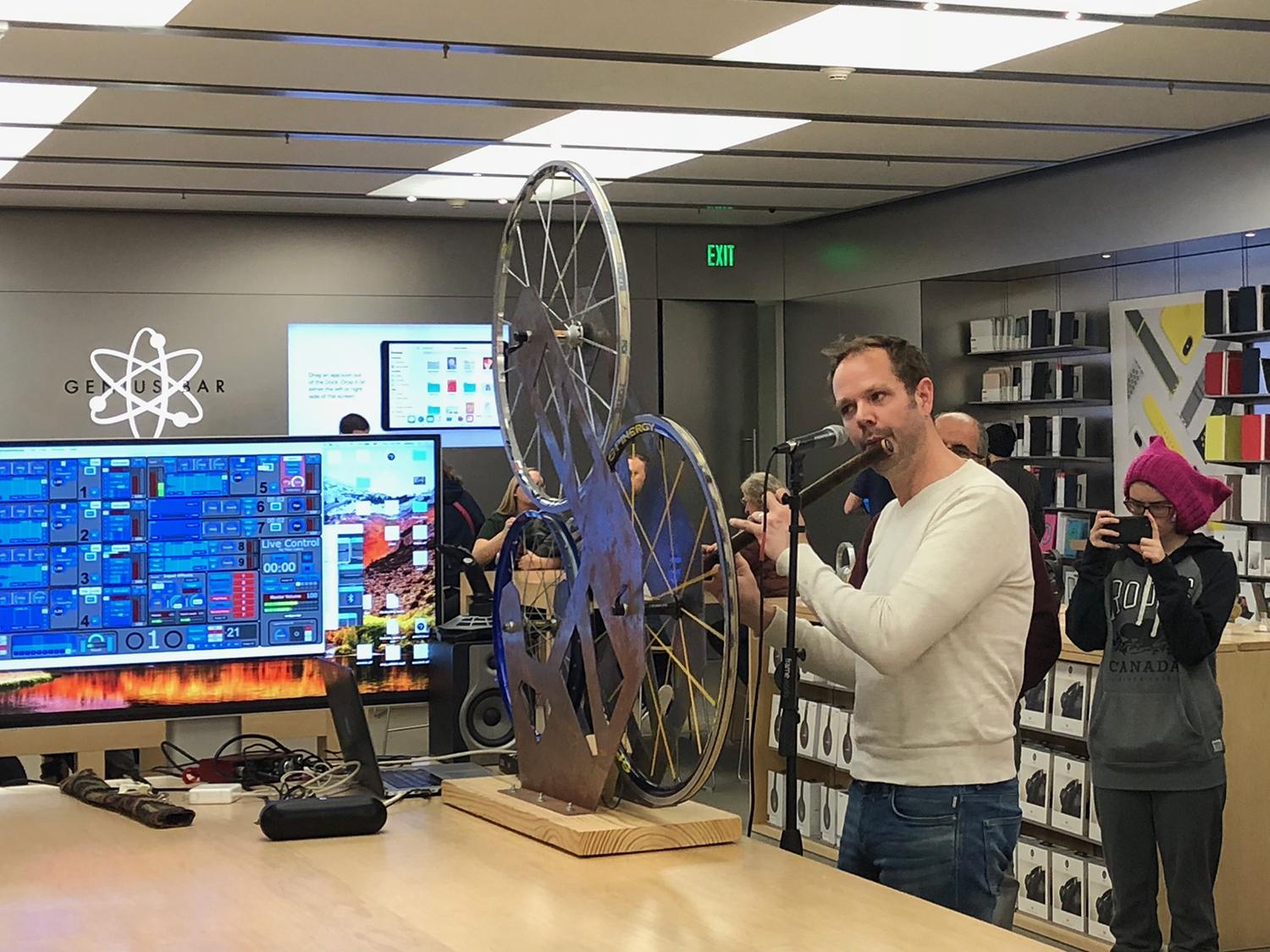Haunting tones -- During a demonstration at the Apple store in Syracuse, SUNY Oswego music faculty member Paul Leary uses a homegrown device to send data to a computer, modifying his flute music electronically to produce other-worldly effects. Leary's composition "Larger Than Us" will premiere in a Jan. 20 performance that the Society of New Music and the MOST in Syracuse are co-hosting to celebrate the 50th anniversary of the NASA's first manned mission to orbit the moon.
UPDATE (Jan. 19): Due to forecast winter storm, this performance has been postponed to a future date.
SUNY Oswego music faculty member Paul Leary has been working hard during winter "break" to finish a composition that meshes music and science, computer programming and artistic skills -- all set to visual and audio offerings from NASA's vast public archives.
Titled "Larger Than Us," the multimedia piece will premiere Sunday, Jan. 20, in a Society of New Music concert at the Museum of Science and Technology in Syracuse. The society and museum are dedicating the evening to a mission in outer space a half-century ago.
Thanks to sophisticated software and hundreds of NASA photos he's animated, Leary makes the galaxies spiral and the planets rotate and the stars sparkle -- all set to original music provided by electronic instruments that Leary has built and a seven-piece chamber ensemble that will perform live on stage.
The video of Leary's other-worldly electronic composition -- though not a full-dome presentation at this time -- will premiere at 4:30 p.m. Sunday, Jan. 20, in the IMAX Theatre at the MOST, 500 S. Franklin St. His "Larger Than Us" will tandem with Charles Fussell's "The Astronaut's Tale," a staged chamber opera modeled after Stravinsky's "The Soldier's Tale."
The concert celebrates the 50th anniversary of America's Apollo 8 manned mission to lunar orbit, which served as a precursor to the mission that gave the world the first man on the moon.
The Society of New Music commissions, at most, one composition a year, and Leary said he was proud to earn the commission in 2018.
"I've always been interested in science and space, in general," said Leary, who specializes in electronic music and has a doctorate in composition from Duke University. "One of the biggest reasons I agreed to do this is that everything NASA publishes is in the public domain."
Adobe's After Effects software enables Leary to animate sequential NASA photos -- taken during the Hubble space telescope mission, among others -- causing celestial objects to move in the video at a visible rate of rotation. A set of Puppet tools allows Leary to bend images according to the positions of pins that he places and moves, simulating motion for three-second intervals, after which the images would begin to deform.
Homegrown instruments
A great deal of computer programming -- and some carpentry -- has gone into the production, Leary said. He is building a new musical instrument for the occasion, a nine-foot pendulum whose motion he initiates. The device uses an accelerometer and a magnetometer to send data back to a computer, electronically changing the pitches and tempos of traditionally produced music.
Another of Leary's homegrown musical instruments is a set of bicycle wheels with Hall effect sensors installed, which uses magnets and an accelerometer to produce haunting electronic effects from, for example, a flute that Leary plays.
"It's so satisfying to make things," Leary said. "People just love those bike wheels."
Another appearance for Leary -- a recital of his original music -- will take place Feb. 10 as part of the SUNY Oswego music department's Focus on Faculty series.
The composer, who also has master's degrees from Duke and the Cleveland Institute of Music, teaches both introductory and advanced electronic music, as well as songwriting, a music theory course and a "Music and Business" course. He also is a coordinator of the audio design and production minor and of SUNY Oswego's MIDI Lab.
For more information on music at SUNY Oswego, visit the music department website or call 315-312-2130.




